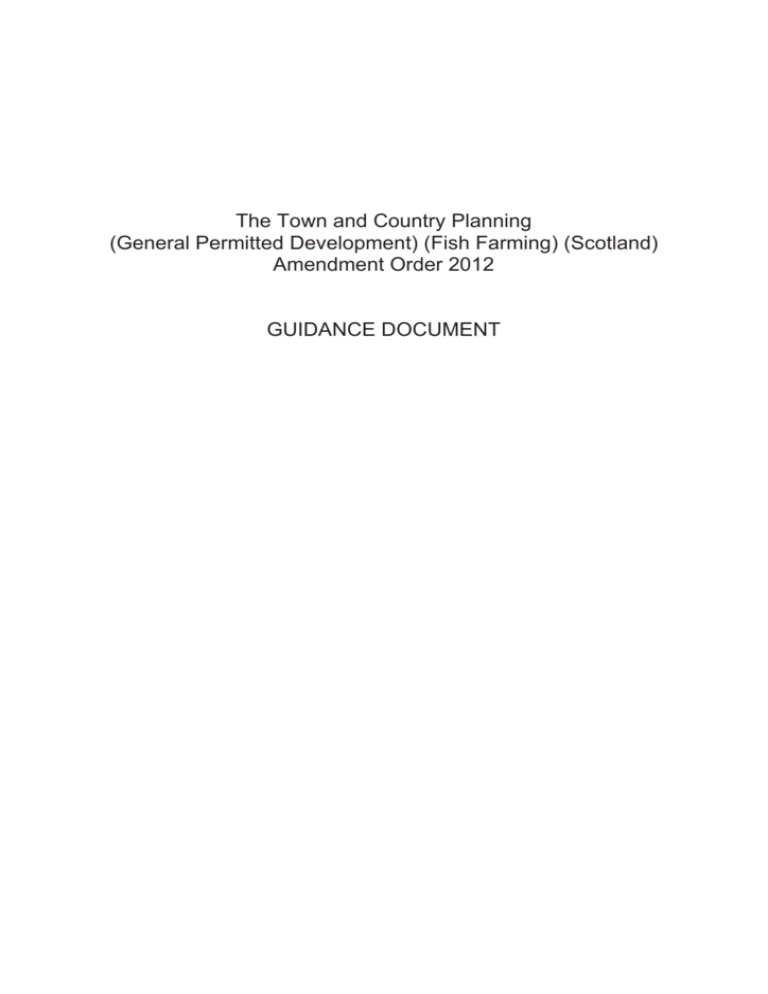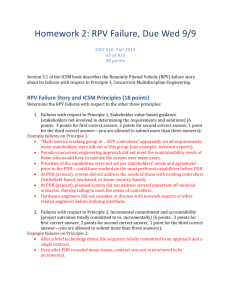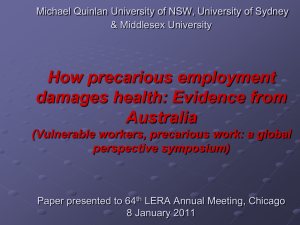PLANNING SERIES - The Scottish Government
advertisement

PLANNING SERIES The Town and Country Planning (General Permitted Development) (Fish Farming) (Scotland) Amendment Order 2012 GUIDANCE DOCUMENT CONTENTS INTRODUCTION DESCRIPTION OF PERMITTED DEVELOPMENTS THE PLANNING BOUNDARY PRIOR NOTIFICATION TO THE PLANNING AUTHORITY ENVIRONMENTAL SCREENING HABITATS REGULATIONS AND APPROPRIATE ASSESSMENT CONSULTATION FEES CONDITIONS UNDER WHICH EACH PDR MAY BE EXERCISED INABILITY OR FAILURE TO COMPLY WITH CONDITIONS FURTHER ADVICE FUTURE STEPS ENQUIRIES INTRODUCTION 1. This Circular explains the provisions of the Town and Country Planning (General Permitted Development) (Fish Farming) (Scotland) Amendment Order 2012 (the Order) which came into force on 1st June 2012. The Order is available from www.legislation.gov.uk/ssi/2012/131/introduction/made 2. An amendment to the Order was made on 25th October 2012 and came into force on the 1st December 2012. The amendment Order is available from www.legislation.gov.uk/ssi/2012/285/introduction/made 3. The Order amends the Town and Country Planning (General Permitted Development) (Scotland) Order 1992 so as to permit the operator of a fish farm to add or change equipment on the farm and to change production from one species to another without the need to apply for planning permission. It does so by introducing a new part – Part 6A: Fish Farming – to Schedule 1 of the principal Order. 4. The Order applies to both fresh water and marine farms and to finfish and shellfish sites. 5. The Order applies to all sites, including those sites which are in the process of applying for permanent planning permission through the Scottish Government Audit and Review process. Further information on the Audit and Review process can be found at http://www.scotland.gov.uk/Topics/marine/Fish-Shellfish/18716/fish-farm/fish-farm. It also applies to sites which were granted planning permission under the Town and Country Planning (Marine Fish Farms Permitted Development) (Scotland) Order 2011. DESCRIPTION OF PERMITTED DEVELOPMENTS 6. The Order grants permitted development rights for the following new Class 21 developments, subject to notifying the planning authority and to certain conditions: CLASS 21A - REPLACING AN EXISTING FINFISH CAGE OR INSTALLING AN ADDITIONAL FINFISH CAGE. 7. The operator of a farm of less than 15,000 square metres in extent may alter their cage configuration by replacing existing cages with cages of a different size or design and to add an additional cage, provided thatprior notification is given to the planning authority and the PDR is exercised in accordance with its determination; the new cage(s), if circular, do not exceed 100m in circumference; the new cage(s), if not circular, do not exceed 796 square metres in area (the equivalent of a 100m circle); the increase in total cage area does not exceed the lesser of 1,000 square metres or 10% of the original total cage area and does not lead to a breach of the 15,000 square metres site limit; there is no increase in the consented biomass. 8. This PDR may be exercised repeatedly, up to the 10%/ 1,000 square metres expansion threshold. 9. Farms larger than 15,000 square metres are excluded from this PDR. 10. The addition of an extra cage must not alter or increase the agreed planning boundary as detailed on the existing planning permission. 11. If your proposed changes under this class are likely to alter the position or increase the benthic footprint of the existing farm then this may require authorisation from SEPA under the Controlled Activities Regulations (CAR) and also may involve a re-run of the modelling. In these cases, we would advise prior discussions with SEPA’s local office operational staff to ascertain if the proposals will require a re-run of the modelling and would be capable of being authorised under CAR.. 12. Examples of PDR under Class 21A: (a) MARINE SALMON FARM A would like to add a 100m cage to their existing site. The existing site consists of 12 x 100m cages. Current equipment = 9552m2 New equipment = 10348m2 Increase in area = 796m2; this is 8% greater. Prior notification should be made to local authority. State size, colour, design and location of cage. Also provide planning boundary for site. (b) MARINE SALMON FARM B would like to add a 90m cage to their existing site. The existing site consists of 10 x 90m cages. Current equipment = 6450m2 New equipment = 7095m2 Increase in area = 645m2; this is 10% greater. Prior notification should be made to local authority. State size, colour, design and location of cage. Also provide planning boundary details for site. Eg. A feed barge can be repositioned to make the site more symmetrical if adding a single cage under PDR CLASS 21B - REPLACING OR REPOSITIONING A FEED BARGE AT A FINFISH FARM. 13. An operator may replace or reposition an existing feed barge, provided that- prior notification is given to the planning authority as to its size, colour, design and, if relevant, new position and the PDR is exercised in accordance with its determination Example of PDR under Class 21B: MARINE SALMON FARM C would like to reposition an existing feed barge to accommodate a new finfish pen. Prior notification should be made to local authority. State size, colour, design and proposed location of feed barge. Also provide planning boundary details for site. CLASS 21C - REPLACING TOP NETS AND THEIR SUPPORT STRUCTURES AT A FINFISH FARM. 14. An operator may replace an existing top net or support with a top net or support of the same size, colour or design or of a different size, colour or design, provided thatprior notification is given to the planning authority as to size, colour, and design of the new netting and supports and the PDR is exercised in accordance with its determination; the height of any new support structures does not exceed 2.5m 15. Example of PDR under Class 21C: MARINE HALIBUT FARM A would like to change the colour of their top nets by replacing the current black top nets with grey ones. Prior notification should be made to local authority. Provide details of size, colour and design. Also provide planning boundary details for site. CLASS 21D - DEPLOYING EQUIPMENT TEMPORARILY (EXCLUDING FISH PENS) AT A FINFISH FARM. 16. An operator may deploy any equipment on a temporary basis (excluding fish pens and equipment permitted by another PDR), provided thatprior notification is given to the planning authority as to size, colour, design and position of the equipment and the PDR is exercised in accordance with its determination; deployment of the temporary equipment does not increase the total surface area of the waters covered by permanent equipment by more than 1%; if a feed barge is present on the site, the height of the temporary equipment does not exceed 50% of the height of any feed barge. Feed barge height is measured from the surface of the water to the top of the feed barge (not including any appendages) and should be the height taken when the feed barge is empty ie at it’s maximum height above the water. if no feed barge is present, the height of the temporary equipment may not exceed 2.5m; that each item of equipment may be deployed for no longer than a three month period, with a 12-month period between each 3 month deployment. 17. Additionally, the operator must notify the planning authority when temporary equipment has been removed, within 14 days of removal taking place. 18. Example of PDR under Class 21D MARINE SALMON FARM B would like to add a generator shed on site between March and May to power underwater lights. This is permitted under PDR Class 21D, assuming that the generator shed is no more than 2.5m high or half the height of the tallest feed barge on site. The equipment could be situated on site between 1st March and 31st May but would not be able to be returned to site (under this PDR) until 1st June the following year as there has to be a 12 month period between deployment. Prior notification should be made to local authority. State size, colour, design and location of new equipment. Also provide planning boundary details for site. CLASS 21E - ADDING LONGLINES AT A SHELLFISH FARM. 19. An operator may add one or more longlines to a shellfish farm, provided that prior notification is given to the planning authority as to the number and size of the additional longlines and that the PDR is exercised in accordance with its determination; the resultant increase in area covered by the longlines does not exceed the lesser of 500 square metres or 10% of that of the original configuration this PDR only applies to longlines at this time. It does not extend to any equivalent shellfish growing structures. 20. For the purposes of this PDR, surface area is calculated on the basis that one linear metre of longline equates to one square metre of surface area. 21. Example of PDR under Class 21E SHELLFISH FARM A would like to add a 200m long-line on site. They currently have 10 x 200m longlines on site. Original site = 2000m2 New Site = 2200m2 Increase = 10% Prior notification should be made to local authority. State size, colour, design and location of long-line. Also provide planning boundary details for site. CLASS 21F - SWITCHING SPECIES FROM ATLANTIC SALMON TO SEA TROUT, RAINBOW TROUT OR HALIBUT 22. An operator may change the use of their farm from that of production of Atlantic salmon to production of either sea trout (and the reverse), rainbow trout (and the reverse) or halibut. 23. For the avoidance of doubt, the PDR does not extend to reversing the change of species being farmed back to Atlantic salmon from halibut, or to switching between either species of trout and halibut. 24. Changes under this class would require a modification to the associated CAR licence if the existing licence does not list the species to be farmed. In such cases discussions with SEPA local office operational staff are advisable prior to carrying out this PDR. 25. Example of PDR under Class 21F MARINE SALMON FARM A would like to change species from Atlanic salmon to halibut. No prior notification required. This change is permitted development and considered noncontenious with no prior approval necessary. Operator should ensure that CAR licence is modified prior to exercising the PDR. THE PLANNING BOUNDARY 26. All equipment changes must be accommodated within the planning boundary. In most cases this will have been established by the planning consent by reference to the farm’s mooring coordinates. 27. Some farms, whose consents were granted through the Scottish Government’s Audit and Review process may have their position referenced by means of the centre point of the site. Some other farms may still be in the process of applying for planning permission through this process. Until such time as the operators of those farms establish a formal planning boundary with the planning authority these sites will not be able to benefit from any PDR where planning boundary is a consideration. 28. To avoid ambiguity for both planners and operators the Order requires site operators, when submitting a prior notification for use of any PDR, to submit, as appropriate, the coordinates of cage grid and longline moorings, surface corners of the cage grid and, if applicable, the centre point of the feed barge. This will enable them to establish the planning boundary of the site. 29. Any equipment deployed out with the planning boundary, purportedly in exercise of a PDR, will constitute a breach of planning control PRIOR NOTIFICATION TO THE PLANNING AUTHORITY 30. An operator is required to give formal prior notification to the planning authority before exercising any equipment PDR, (development Classes 21A, 21B, 21C, 21D, and 21E) 31. The purpose of prior approval is, firstly, to allow the planning authority to screen equipment changes for visual impacts in potentially visually sensitive areas and for them to be able to impose suitable mitigating conditions. This is particularly important in relation to National Scenic Areas (NSA’s) which have been designated to ensure that they are protected from any inappropriate development. Secondly, it is to allow the planning authority to screen a change for its potential environmental impacts and particularly impacts on designated sites. 32. The planning authority has 28 days from receipt of the notification to issue a determination as to whether its prior approval is required to the exercise of the PDR. If it does not do so by then the operator becomes entitled to make the change. 33. Where the planning authority determines that its approval is required, it has 2 months in which to determine the case. If prior approval is refused or granted with conditions, the applicant has a right to appeal to the Scottish Ministers under Section 47(1)(c) of the Town and Country Planning (Scotland) Act 1997. If the prior approval is not determined, they similarly have a right of appeal under Section 47(2) of the same Act. ENVIRONMENTAL SCREENING 34. Most development associated with finfish farms is Schedule 2 development under the Town and Country Planning (Environmental Impact Assessment) (Scotland) Regulations. Currently the legislation on permitted development is such that PDRs are not granted for Schedule 2 development unless the planning authority has adopted a screening opinion to the effect that EIA is not required. Scottish Government Circular 3/2011 (paragraphs 7175 refer) explains the relationship between PDRs, prior approvals, and EIA. 35. For schedule 2 development, EIA screening may be undertaken either on receipt of a screening request from the developer, or on receipt of an application for prior approval. PDRs for fish farms will be subject to the same arrangements. HABITATS REGULATIONS AND APPROPRIATE ASSESSMENT 36. The Habitats Regulations require competent authorities to assess plans or projects which affect Natura sites. Permitted development may require consideration under the Habitats Directive if it is likely to have a significant effect on a Natura Site, in which case specific approval for the development must be sought from the planning authority. The Scottish Government’s Circular of June 2000 “The Habitats and Birds Directives” gives further information. 37. Authorities undertaking a Habitats Regulations Appraisal should consult SNH when determining likely significant effect and before concluding that an appropriate assessment is not required. Where an appropriate assessment is required, the authority must consult SNH and should have regard to any representations they may make. Where, following that assessment, the authority cannot conclude that the plan would not adversely affect the integrity of any European site(s), permitted development would no longer apply and a new planning application would be required if the applicant wanted to progress any further. CONSULTATION 38. Statutory consultees for fish farm development are: SEPA, Marine Scotland Science, SNH and the local District Salmon Fisheries Board. Each will have been consulted on the planning application for the farm before consent was granted but it is not necessary for each to be consulted again whenever a PDR is about to be exercised. Planning authorities need only consult those organisations with a direct interest in the type of PDR being exercised and this is at the discretion of the planning authority. For example, SEPA has no interest in changes to top netting or a feed barge but will have if additional or new style cages are being deployed. Adopting a discrete approach to consultation will ensure that agencies and regulators are not burdened with the registration and case handling demands of issues that are of no consequence to them. 39. The following table provides guidance for planning authorities on which consultee to contact for each Class : CONSULTEE CLASS 21A SEPA SNH IF CHANGE TO BENTHIC FOOTPRINT ONLY IF WITHIN OR AFFECTING NATURA SITES AND NSA’S OR MPA’S CLASS 21B X ONLY IF WITHIN OR AFFECTING NATURA SITES AND NSA’s OR MPA’S CLASS 21C X ONLY IF WITHIN OR AFFECTING NATURA SITES AND NSA’s OR MPA’S CLASS 21D X ONLY IF WITHIN OR AFFECTING NATURA SITES AND NSA’s OR MPA’S CLASS 21E IF SPECIFIC ADVICE REQ ONLY IF WITHIN OR AFFECTING NATURA SITES AND NSA’s OR MPA’S MSS X X X DSFB X X X FEES 40. The existing prior notification fee (currently £61) will apply to the prior notification of fish farm PDRs. CONDITIONS UNDER WHICH EACH PDR MAY BE EXERCISED 41. The Order includes one condition under which each PDR may be exercised. For all PDRs, excluding Class 21F (change of species), this isIn the event of equipment falling into disrepair or becoming damaged, adrift, stranded, abandoned or sunk in such a manner as to cause an obstruction or danger to navigation, such works (including lighting, buoying, raising, repairing, moving or destroying the whole or any part of that equipment) as may be needed to remove the obstruction or danger to navigation must be carried out. Reason: In the interests of navigational safety. 42. PDR development is required to be carried out within a period of three years from the date on which all approvals required are given. 43. Planning conditions will have been placed on the original planning permission for the site. These conditions must still be adhered to. INABILITY OR FAILURE TO COMPLY WITH CONDITIONS 44. If an operator is unable to comply with the prescribed conditions they will be required to obtain formal planning consent for the changes they propose to make. 45. It is for the planning authority to consider what, if any, enforcement action to take should it appear that equipment deployed in exercise of a PDR does not meet the conditions of the Order. FURTHER ADVICE 46. Further advice on siting and design can be found in the Scottish Government’s Planning Advice Note (PAN) 45 and, from SNH, Marine Aquaculture and the Landscape: The siting and design of marine aquaculture developments in the landscape, available at www.snh.gov.uk/publications-data-and-research/publications/search-thecatalogue/publication-detail/?id=113. 57. The prior notification forms available from the e-planning website are in the process of being updated to reflect the changes introduced by the Order. The guidance will also be updated to reflect the changes. In the meantime local authorities have produced a standard prior notification form which is available to download from their respective websites. FUTURE STEPS 51. The Order can be considered a working document which is relevant to the current aquaculture industry. A review of the Order is proposed within the year following introduction. This will allow operators and planning authorities to assess how beneficial the PDRs are and for Scottish Government to determine whether any amendments to the Order are required. ENQUIRIES 52. Any enquiries about this guidance document should be addressed to Aquaculture Planning, Marine Scotland, Victoria Quay, Edinburgh, EH6 6QQ, Telephone 0131 244 6225 / email fishfarmreview@scotland.gsi.gov.uk







